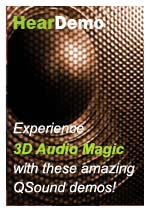3D Audio Technologies
Stereo or surround audio reproduction relies on illusion to create a believable acoustic image or sound stage, in which instruments, voices and sound effects appear to originate from physical locations other than the actual speakers or headphones.
If both speakers of a stereo system produce the identical sound, a properly-positioned listener will perceive the sound as if it was originating from a point midway between the speakers. By varying relative left/right signal strength, apparent sound locations can be created at any point between the speakers – but not beyond. This is the limit of the stereo illusion.
QSound Labs Spatial Audio Technologies extend this illusion beyond its normal boundaries, allowing for a more natural, expansive and immersive sound stage for any delivery system having at least two output transducers – i.e. stereo headphones / earphones / earbuds, and stereo or multi-channel speaker systems.
QSound 3D Building Block
The basic QSound 3D building block is a proprietary audio process that creates two or more outputs from each input signal. These outputs incorporate subtle differences in level, frequency content, and timing. Played back on the specific delivery system (headphones or speaker arrangement) for which the algorithm is designed, the effect is to mimic directional cues that a listener would normally receive when listening to an actual sound source at a given location in 3D space.
The basic QSound 3D building blocks are combined with additional processing to produce a suite of algorithms that maximize the spatial potential of virtually any configuration.
3D Positional Audio
Q3D™ is a 3D sound positioning technology that is closely coupled to a multi-channel mix engine. Q3D takes one or more signals representing individual voices, instruments or sound effects, applies processing to position each input independently at the chosen location in 3D space, and mixes the results down to the number of channels required for the target delivery system, whether stereo earphones, speakers, or multi-speaker surround systems.
Q3D Positional Audio is useful in the production of music or soundtracks where the sound positioning requirements are known at production time, and the finished product will sound the same way each time it is played. In this case, sound processing occurs in the creative environment, while the consumer receives a product with built-in QSound 3D positional audio effects that require no special decoding equipment to enjoy.
Q3D Interactive (Q3DI) is applied directly in the end-user environment via software running on a computer PC, a digital signal processing (DSP) chip in a game console or cell phone, a computer audio driver or sound card. Optimized for low overhead real-time performance, Q3DI handles all aspects of sound control (start/stop, level, pitch and more) in addition to 3D placement. Q3DI positional audio is chiefly applied in video games, in which the behaviour of sound is designed in the creative environment, but the actual processing and positioning of sound happens at the time of game play according to game logic and user input.
Environmental Audio Modeling
QSound Environmental Modeling® (QEM®) is a component of Q3DI that simulates the characteristics of various acoustic environments such as rooms of various sizes, hallways, caves and more, using echo and reverberation. Echo and “reverb” are both the result of sound waves reflecting back to the listener from surrounding surfaces or objects. Like other aspects of Q3DI sound control, QEM environments are selected and modified by game logic in real time during game play to match the situations encountered by the player.
Q3DInteractive and QEM are components of the microQ and microQ JSR-234 portable digital audio libraries.
Stereo Expansion
QXpander Stereo Expansion creates a more enjoyable listening experience from existing stereo source material by increasing the width, immersiveness—and thus realism—of the sound stage.
Based on the Q3D positional 3D audio algorithms used in professional music and video production, the QXpander process is carefully designed to maintain the integrity of the original stereo mix. QXpander widens the original sound stage proportionately, leaving center elements strong and introducing a minimum of undesireable spectral colouration.
QXpander is available for earphone or speaker targets, and is broadly applicable in computer and handheld audio as well as consumer entertainment electronics since it can be applied to arbitrary source material on end-user equipment. Although QXpander does not depend on special content production techniques, it can and has been used in professional production.
Mono-to-3D
A special case of enhancement, mono-to-3D creates an ‘omnidirectional’ 3D stereo sound stage for a more lively and engaging listening experience that better matches stereo content. Mono-to-3D is an option on certain QXpander implementations.
QXpander is available as a stand-alone algorithm, and as a feature of QHD, microQ, and mQFX. Non-programmable platforms are served by the low-cost QX2020 analog signal processor and the unique QS7779 Matrix Surround Decoder/Virtualizer.
Surround Virtualization & Enhancement
Virtual Surround Sound
QSurround® Virtual Surround renders fully decoded multi-channel formats such as Dolby Digital effectively on headphones or as few as two speakers. Multiple 3D audio processes are applied to the decoded surround channels in order to create virtual surround speakers (using positional 3D, or mono-to-3D, for stereo and mono surround signals respectively) and to improve the apparent separation of the front channels. The individual processes outputs are then down- mixed, typically to two channels. Most QSurround implementations include the QXpander stereo enhancement algorithm, providing multi-format compatibility.
Primary applications of QSound virtual surround sound are home theatre (See QSurround), desktop computers, and Mobile TV (See QSurround Mobile).
A unique packaging of surround virtualization can be found in the QS7779 analog audio IC, which directly decodes and virtualizes matrix surround (e.g. Dolby Surround) as well as automatically expanding stereo content using the QXpander algorithm.
Surround Enhancement
Surround enhancement is akin to stereo enhancement in a multi-speaker setting. QSurround Surround Enhancement fills in areas that are traditionally weak in the surround sound stage (especially the sonic gap that tends to exist between front and surround speakers) resulting in a more continuous and immersive sound stage with reduced listener awareness of actual speaker locations. (See QSurround)
Surround Synthesis
The unique QSound Multi-Speaker (QMSS™) algorithm creates 3, 4, 5, 5.1 or 7.1-channel output from plain mono or stereo input. Well suited to multi-channel PC audio systems, home theatre, compact surround systems and car audio, the QMSS process imparts the impression that the content was produced in multi-channel surround. Considering that most available content is still in mono or stereo formats, QMSS adds significant value to multi-speaker system.
Since QMSS can also be used to resynthesize multi-channel output from decoded and down-mixed surround content, it can serve as an economical alternative to the high licensing costs associated with full multi-channel decoding and output. If implemented using one of the company's analog integrated circuits, D/A cost reductions can also be realized.

